Tuberculosis: Causes, Symptoms, Diagnosis, Treatment and Prevention
VerifiedAdded on 2023/04/23
|7
|1562
|144
Report
AI Summary
This report provides a comprehensive overview of Tuberculosis (TB), a disease that has co-evolved with humans for centuries. It identifies Mycobacterium tuberculosis as the primary causative agent and discusses different types of TB, including latent and active forms. The report details the symptoms, diagnosis methods such as skin tests, blood tests, and chest X-rays, and treatment options, emphasizing the importance of antibiotic adherence. It also touches on holistic and traditional treatments, highlighting that they should not replace modern medicine. Furthermore, it addresses the economic impact of TB on individuals, communities, and healthcare systems, noting the strain on resources and the challenges faced by affected families. The report concludes by stressing the curable nature of TB while pointing out the significant number of undiagnosed cases, advocating for regular screening to improve early detection and treatment outcomes. Desklib offers this and many other solved assignments for students.
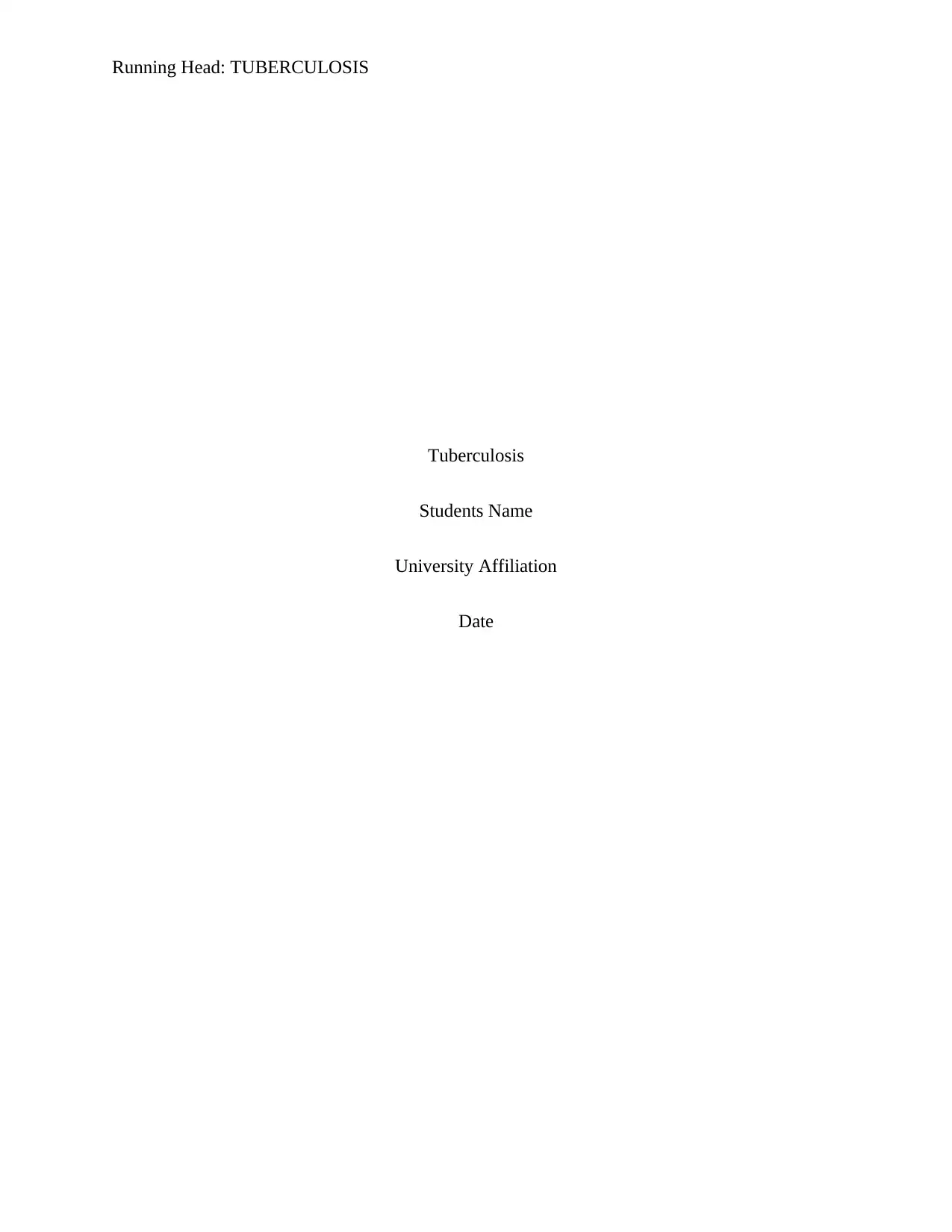
Running Head: TUBERCULOSIS
Tuberculosis
Students Name
University Affiliation
Date
Tuberculosis
Students Name
University Affiliation
Date
Paraphrase This Document
Need a fresh take? Get an instant paraphrase of this document with our AI Paraphraser
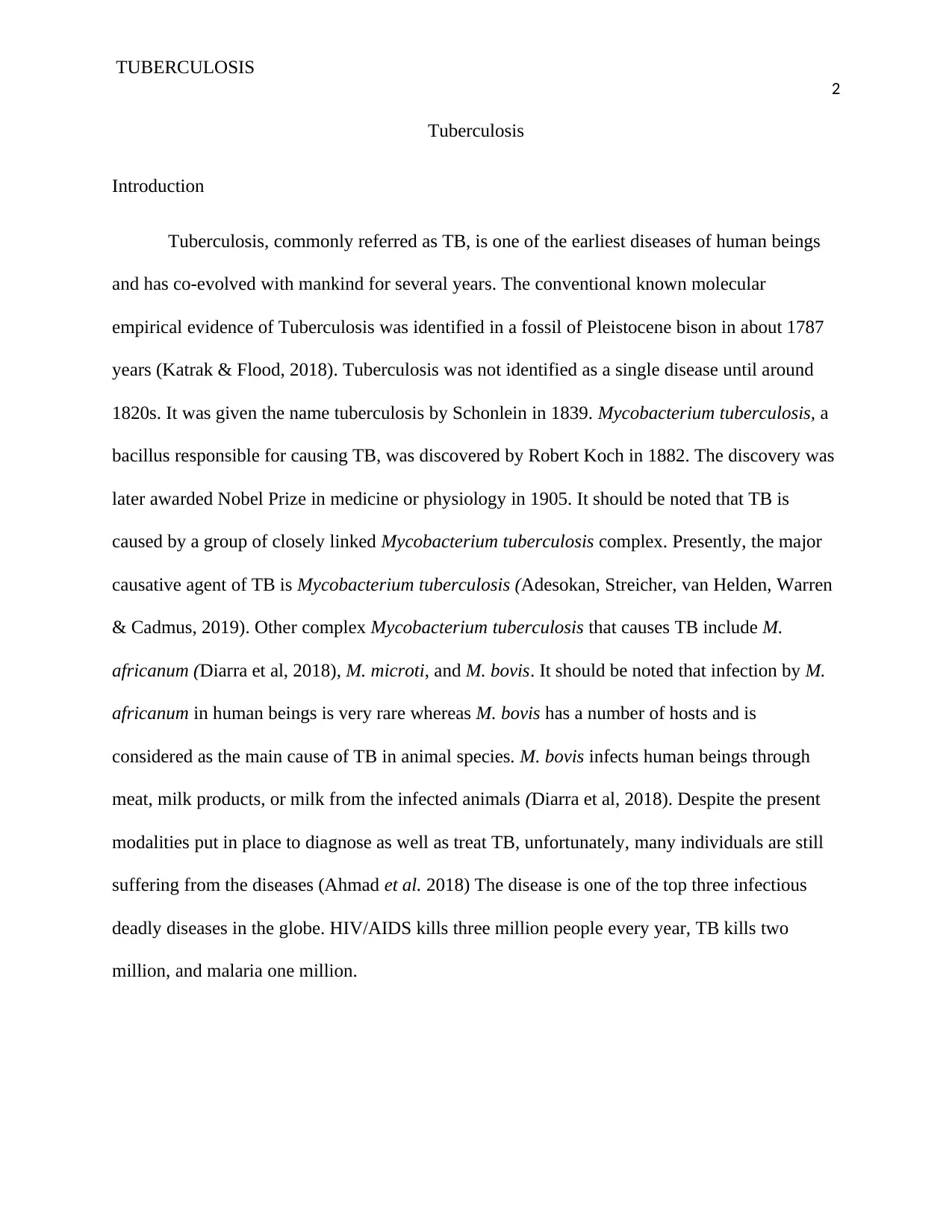
TUBERCULOSIS
2
Tuberculosis
Introduction
Tuberculosis, commonly referred as TB, is one of the earliest diseases of human beings
and has co-evolved with mankind for several years. The conventional known molecular
empirical evidence of Tuberculosis was identified in a fossil of Pleistocene bison in about 1787
years (Katrak & Flood, 2018). Tuberculosis was not identified as a single disease until around
1820s. It was given the name tuberculosis by Schonlein in 1839. Mycobacterium tuberculosis, a
bacillus responsible for causing TB, was discovered by Robert Koch in 1882. The discovery was
later awarded Nobel Prize in medicine or physiology in 1905. It should be noted that TB is
caused by a group of closely linked Mycobacterium tuberculosis complex. Presently, the major
causative agent of TB is Mycobacterium tuberculosis (Adesokan, Streicher, van Helden, Warren
& Cadmus, 2019). Other complex Mycobacterium tuberculosis that causes TB include M.
africanum (Diarra et al, 2018), M. microti, and M. bovis. It should be noted that infection by M.
africanum in human beings is very rare whereas M. bovis has a number of hosts and is
considered as the main cause of TB in animal species. M. bovis infects human beings through
meat, milk products, or milk from the infected animals (Diarra et al, 2018). Despite the present
modalities put in place to diagnose as well as treat TB, unfortunately, many individuals are still
suffering from the diseases (Ahmad et al. 2018) The disease is one of the top three infectious
deadly diseases in the globe. HIV/AIDS kills three million people every year, TB kills two
million, and malaria one million.
2
Tuberculosis
Introduction
Tuberculosis, commonly referred as TB, is one of the earliest diseases of human beings
and has co-evolved with mankind for several years. The conventional known molecular
empirical evidence of Tuberculosis was identified in a fossil of Pleistocene bison in about 1787
years (Katrak & Flood, 2018). Tuberculosis was not identified as a single disease until around
1820s. It was given the name tuberculosis by Schonlein in 1839. Mycobacterium tuberculosis, a
bacillus responsible for causing TB, was discovered by Robert Koch in 1882. The discovery was
later awarded Nobel Prize in medicine or physiology in 1905. It should be noted that TB is
caused by a group of closely linked Mycobacterium tuberculosis complex. Presently, the major
causative agent of TB is Mycobacterium tuberculosis (Adesokan, Streicher, van Helden, Warren
& Cadmus, 2019). Other complex Mycobacterium tuberculosis that causes TB include M.
africanum (Diarra et al, 2018), M. microti, and M. bovis. It should be noted that infection by M.
africanum in human beings is very rare whereas M. bovis has a number of hosts and is
considered as the main cause of TB in animal species. M. bovis infects human beings through
meat, milk products, or milk from the infected animals (Diarra et al, 2018). Despite the present
modalities put in place to diagnose as well as treat TB, unfortunately, many individuals are still
suffering from the diseases (Ahmad et al. 2018) The disease is one of the top three infectious
deadly diseases in the globe. HIV/AIDS kills three million people every year, TB kills two
million, and malaria one million.
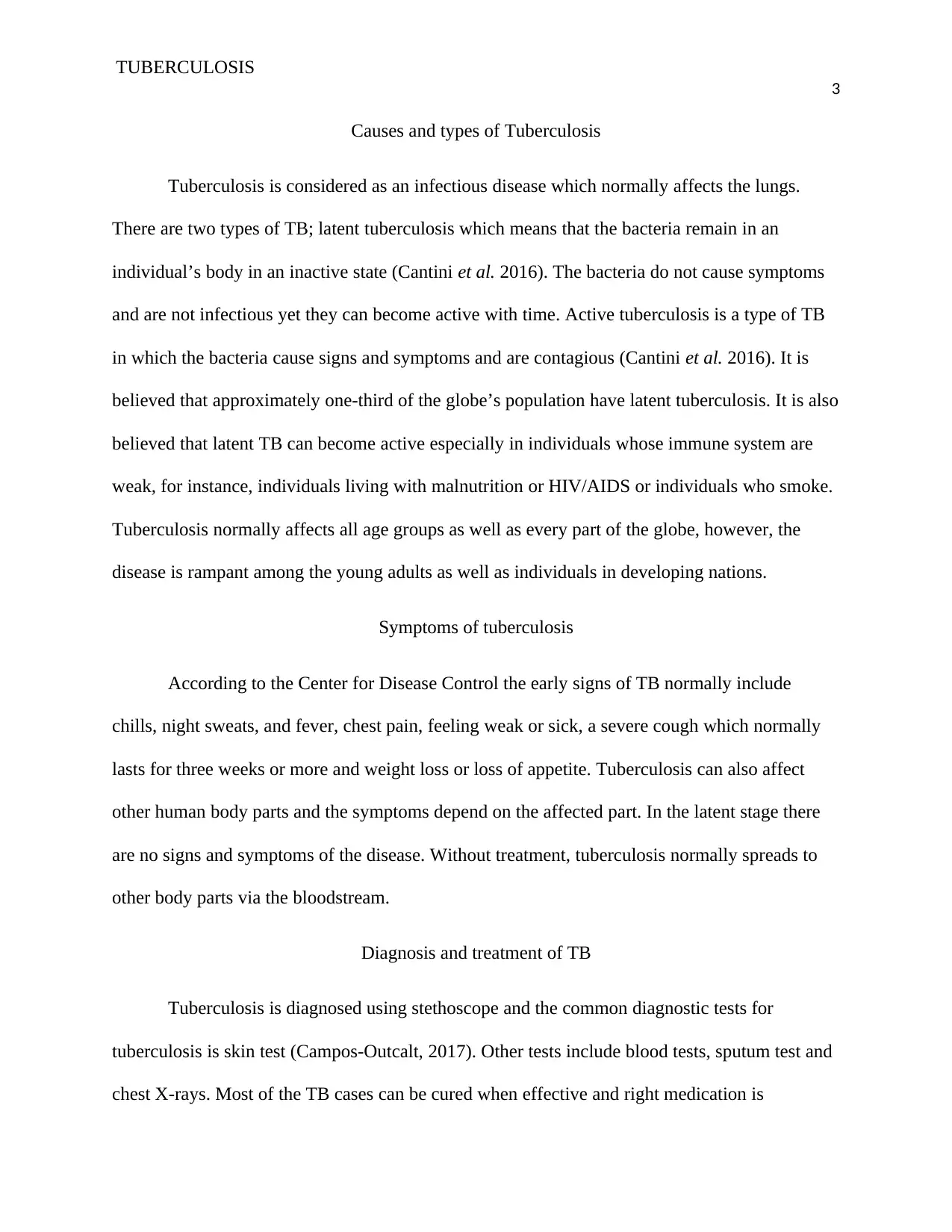
TUBERCULOSIS
3
Causes and types of Tuberculosis
Tuberculosis is considered as an infectious disease which normally affects the lungs.
There are two types of TB; latent tuberculosis which means that the bacteria remain in an
individual’s body in an inactive state (Cantini et al. 2016). The bacteria do not cause symptoms
and are not infectious yet they can become active with time. Active tuberculosis is a type of TB
in which the bacteria cause signs and symptoms and are contagious (Cantini et al. 2016). It is
believed that approximately one-third of the globe’s population have latent tuberculosis. It is also
believed that latent TB can become active especially in individuals whose immune system are
weak, for instance, individuals living with malnutrition or HIV/AIDS or individuals who smoke.
Tuberculosis normally affects all age groups as well as every part of the globe, however, the
disease is rampant among the young adults as well as individuals in developing nations.
Symptoms of tuberculosis
According to the Center for Disease Control the early signs of TB normally include
chills, night sweats, and fever, chest pain, feeling weak or sick, a severe cough which normally
lasts for three weeks or more and weight loss or loss of appetite. Tuberculosis can also affect
other human body parts and the symptoms depend on the affected part. In the latent stage there
are no signs and symptoms of the disease. Without treatment, tuberculosis normally spreads to
other body parts via the bloodstream.
Diagnosis and treatment of TB
Tuberculosis is diagnosed using stethoscope and the common diagnostic tests for
tuberculosis is skin test (Campos-Outcalt, 2017). Other tests include blood tests, sputum test and
chest X-rays. Most of the TB cases can be cured when effective and right medication is
3
Causes and types of Tuberculosis
Tuberculosis is considered as an infectious disease which normally affects the lungs.
There are two types of TB; latent tuberculosis which means that the bacteria remain in an
individual’s body in an inactive state (Cantini et al. 2016). The bacteria do not cause symptoms
and are not infectious yet they can become active with time. Active tuberculosis is a type of TB
in which the bacteria cause signs and symptoms and are contagious (Cantini et al. 2016). It is
believed that approximately one-third of the globe’s population have latent tuberculosis. It is also
believed that latent TB can become active especially in individuals whose immune system are
weak, for instance, individuals living with malnutrition or HIV/AIDS or individuals who smoke.
Tuberculosis normally affects all age groups as well as every part of the globe, however, the
disease is rampant among the young adults as well as individuals in developing nations.
Symptoms of tuberculosis
According to the Center for Disease Control the early signs of TB normally include
chills, night sweats, and fever, chest pain, feeling weak or sick, a severe cough which normally
lasts for three weeks or more and weight loss or loss of appetite. Tuberculosis can also affect
other human body parts and the symptoms depend on the affected part. In the latent stage there
are no signs and symptoms of the disease. Without treatment, tuberculosis normally spreads to
other body parts via the bloodstream.
Diagnosis and treatment of TB
Tuberculosis is diagnosed using stethoscope and the common diagnostic tests for
tuberculosis is skin test (Campos-Outcalt, 2017). Other tests include blood tests, sputum test and
chest X-rays. Most of the TB cases can be cured when effective and right medication is
⊘ This is a preview!⊘
Do you want full access?
Subscribe today to unlock all pages.

Trusted by 1+ million students worldwide
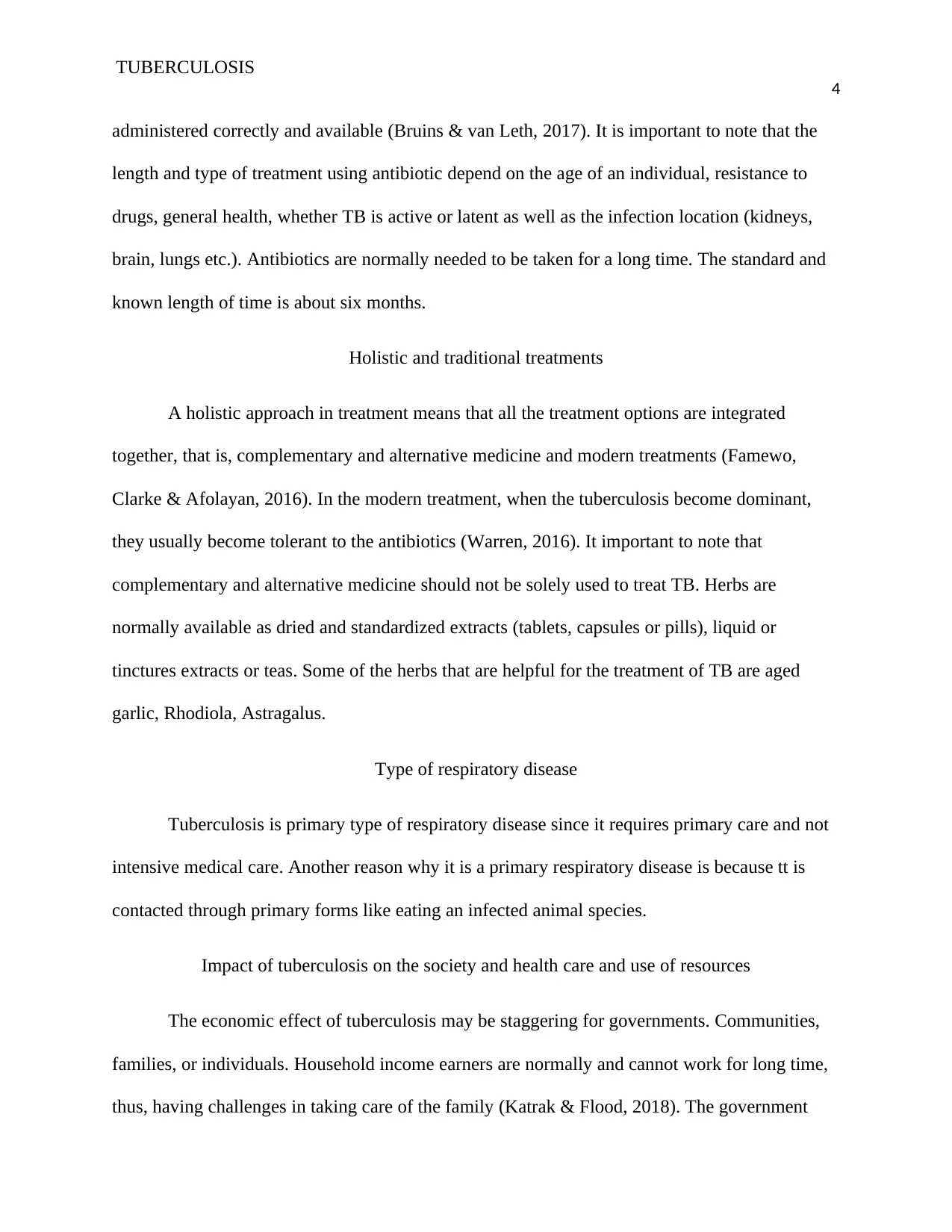
TUBERCULOSIS
4
administered correctly and available (Bruins & van Leth, 2017). It is important to note that the
length and type of treatment using antibiotic depend on the age of an individual, resistance to
drugs, general health, whether TB is active or latent as well as the infection location (kidneys,
brain, lungs etc.). Antibiotics are normally needed to be taken for a long time. The standard and
known length of time is about six months.
Holistic and traditional treatments
A holistic approach in treatment means that all the treatment options are integrated
together, that is, complementary and alternative medicine and modern treatments (Famewo,
Clarke & Afolayan, 2016). In the modern treatment, when the tuberculosis become dominant,
they usually become tolerant to the antibiotics (Warren, 2016). It important to note that
complementary and alternative medicine should not be solely used to treat TB. Herbs are
normally available as dried and standardized extracts (tablets, capsules or pills), liquid or
tinctures extracts or teas. Some of the herbs that are helpful for the treatment of TB are aged
garlic, Rhodiola, Astragalus.
Type of respiratory disease
Tuberculosis is primary type of respiratory disease since it requires primary care and not
intensive medical care. Another reason why it is a primary respiratory disease is because tt is
contacted through primary forms like eating an infected animal species.
Impact of tuberculosis on the society and health care and use of resources
The economic effect of tuberculosis may be staggering for governments. Communities,
families, or individuals. Household income earners are normally and cannot work for long time,
thus, having challenges in taking care of the family (Katrak & Flood, 2018). The government
4
administered correctly and available (Bruins & van Leth, 2017). It is important to note that the
length and type of treatment using antibiotic depend on the age of an individual, resistance to
drugs, general health, whether TB is active or latent as well as the infection location (kidneys,
brain, lungs etc.). Antibiotics are normally needed to be taken for a long time. The standard and
known length of time is about six months.
Holistic and traditional treatments
A holistic approach in treatment means that all the treatment options are integrated
together, that is, complementary and alternative medicine and modern treatments (Famewo,
Clarke & Afolayan, 2016). In the modern treatment, when the tuberculosis become dominant,
they usually become tolerant to the antibiotics (Warren, 2016). It important to note that
complementary and alternative medicine should not be solely used to treat TB. Herbs are
normally available as dried and standardized extracts (tablets, capsules or pills), liquid or
tinctures extracts or teas. Some of the herbs that are helpful for the treatment of TB are aged
garlic, Rhodiola, Astragalus.
Type of respiratory disease
Tuberculosis is primary type of respiratory disease since it requires primary care and not
intensive medical care. Another reason why it is a primary respiratory disease is because tt is
contacted through primary forms like eating an infected animal species.
Impact of tuberculosis on the society and health care and use of resources
The economic effect of tuberculosis may be staggering for governments. Communities,
families, or individuals. Household income earners are normally and cannot work for long time,
thus, having challenges in taking care of the family (Katrak & Flood, 2018). The government
Paraphrase This Document
Need a fresh take? Get an instant paraphrase of this document with our AI Paraphraser
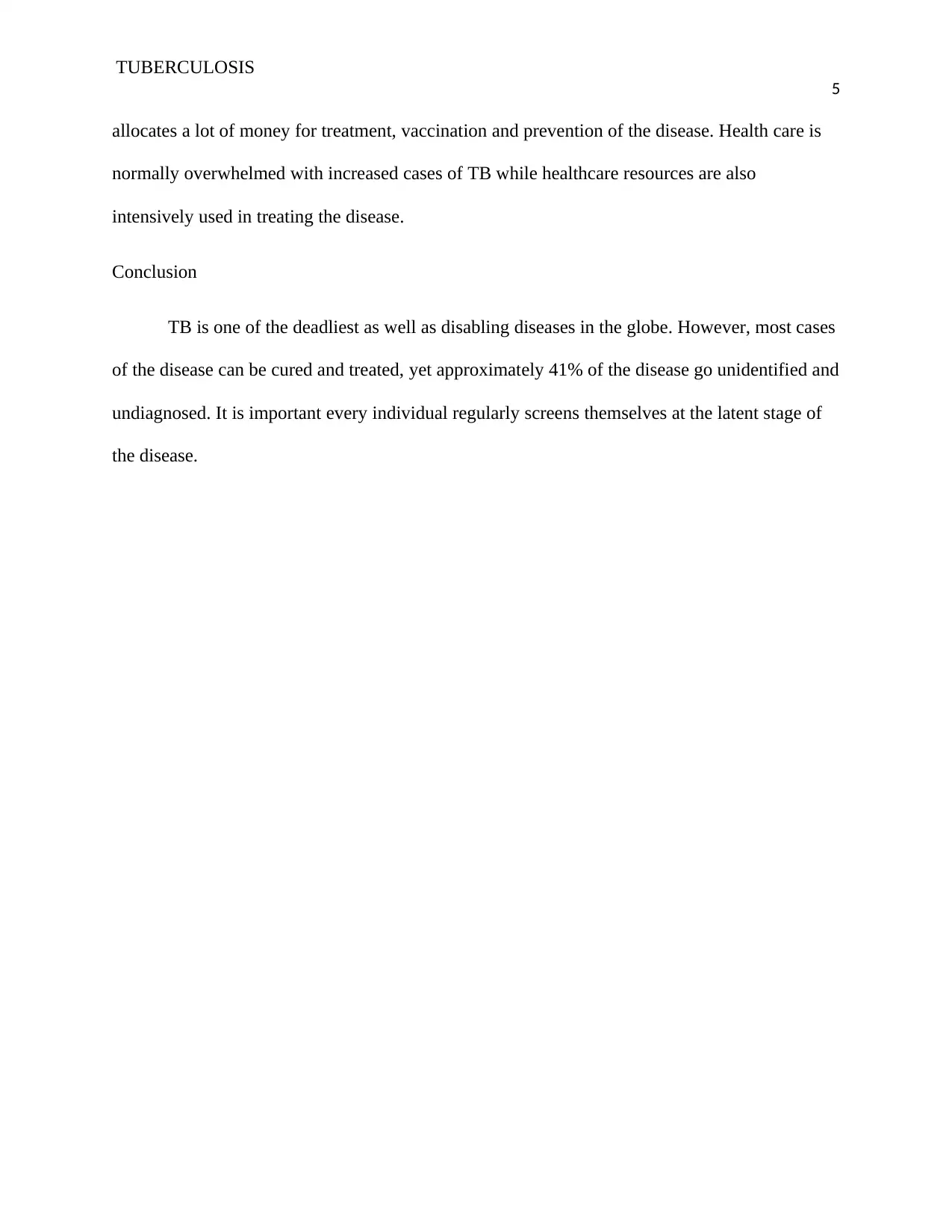
TUBERCULOSIS
5
allocates a lot of money for treatment, vaccination and prevention of the disease. Health care is
normally overwhelmed with increased cases of TB while healthcare resources are also
intensively used in treating the disease.
Conclusion
TB is one of the deadliest as well as disabling diseases in the globe. However, most cases
of the disease can be cured and treated, yet approximately 41% of the disease go unidentified and
undiagnosed. It is important every individual regularly screens themselves at the latent stage of
the disease.
5
allocates a lot of money for treatment, vaccination and prevention of the disease. Health care is
normally overwhelmed with increased cases of TB while healthcare resources are also
intensively used in treating the disease.
Conclusion
TB is one of the deadliest as well as disabling diseases in the globe. However, most cases
of the disease can be cured and treated, yet approximately 41% of the disease go unidentified and
undiagnosed. It is important every individual regularly screens themselves at the latent stage of
the disease.
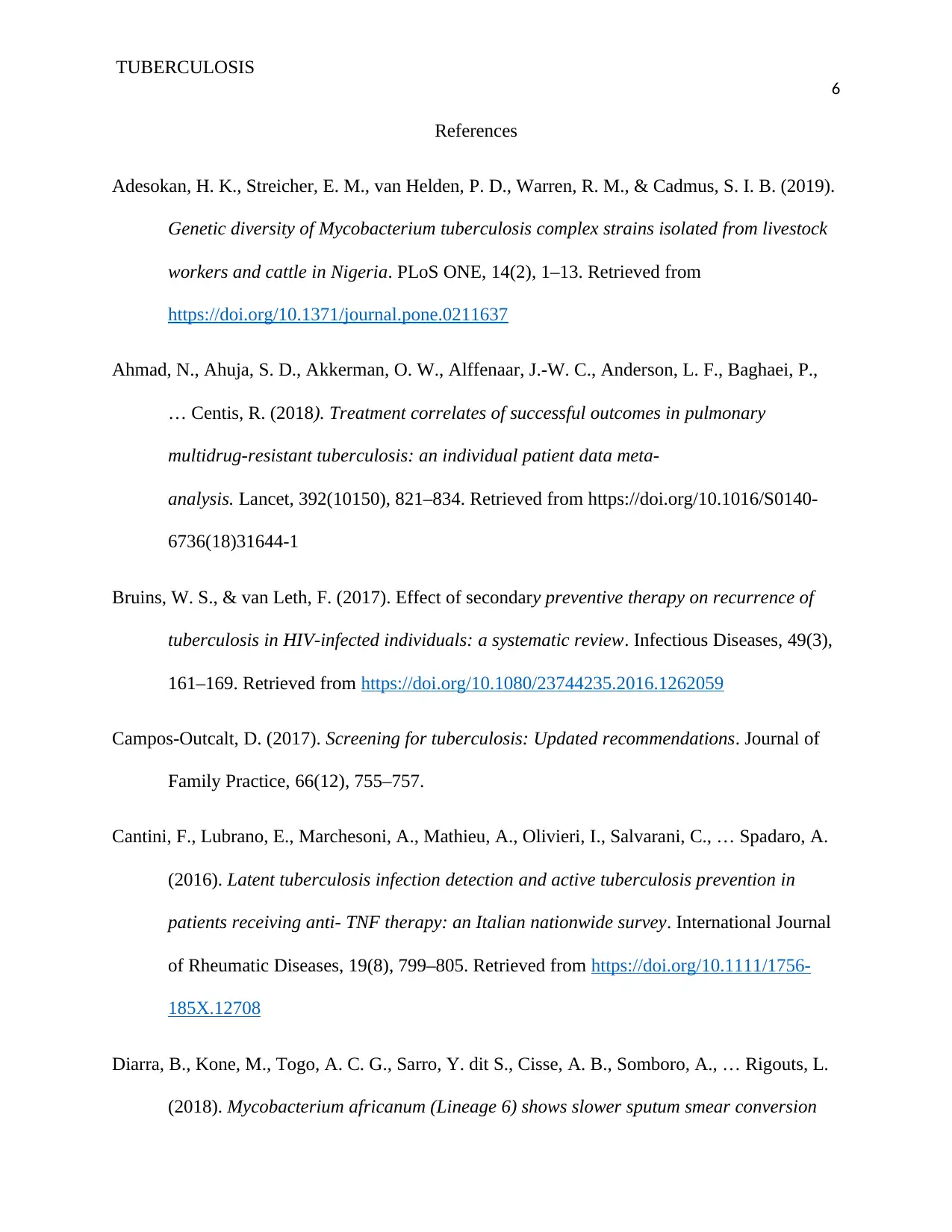
TUBERCULOSIS
6
References
Adesokan, H. K., Streicher, E. M., van Helden, P. D., Warren, R. M., & Cadmus, S. I. B. (2019).
Genetic diversity of Mycobacterium tuberculosis complex strains isolated from livestock
workers and cattle in Nigeria. PLoS ONE, 14(2), 1–13. Retrieved from
https://doi.org/10.1371/journal.pone.0211637
Ahmad, N., Ahuja, S. D., Akkerman, O. W., Alffenaar, J.-W. C., Anderson, L. F., Baghaei, P.,
… Centis, R. (2018). Treatment correlates of successful outcomes in pulmonary
multidrug-resistant tuberculosis: an individual patient data meta-
analysis. Lancet, 392(10150), 821–834. Retrieved from https://doi.org/10.1016/S0140-
6736(18)31644-1
Bruins, W. S., & van Leth, F. (2017). Effect of secondary preventive therapy on recurrence of
tuberculosis in HIV-infected individuals: a systematic review. Infectious Diseases, 49(3),
161–169. Retrieved from https://doi.org/10.1080/23744235.2016.1262059
Campos-Outcalt, D. (2017). Screening for tuberculosis: Updated recommendations. Journal of
Family Practice, 66(12), 755–757.
Cantini, F., Lubrano, E., Marchesoni, A., Mathieu, A., Olivieri, I., Salvarani, C., … Spadaro, A.
(2016). Latent tuberculosis infection detection and active tuberculosis prevention in
patients receiving anti- TNF therapy: an Italian nationwide survey. International Journal
of Rheumatic Diseases, 19(8), 799–805. Retrieved from https://doi.org/10.1111/1756-
185X.12708
Diarra, B., Kone, M., Togo, A. C. G., Sarro, Y. dit S., Cisse, A. B., Somboro, A., … Rigouts, L.
(2018). Mycobacterium africanum (Lineage 6) shows slower sputum smear conversion
6
References
Adesokan, H. K., Streicher, E. M., van Helden, P. D., Warren, R. M., & Cadmus, S. I. B. (2019).
Genetic diversity of Mycobacterium tuberculosis complex strains isolated from livestock
workers and cattle in Nigeria. PLoS ONE, 14(2), 1–13. Retrieved from
https://doi.org/10.1371/journal.pone.0211637
Ahmad, N., Ahuja, S. D., Akkerman, O. W., Alffenaar, J.-W. C., Anderson, L. F., Baghaei, P.,
… Centis, R. (2018). Treatment correlates of successful outcomes in pulmonary
multidrug-resistant tuberculosis: an individual patient data meta-
analysis. Lancet, 392(10150), 821–834. Retrieved from https://doi.org/10.1016/S0140-
6736(18)31644-1
Bruins, W. S., & van Leth, F. (2017). Effect of secondary preventive therapy on recurrence of
tuberculosis in HIV-infected individuals: a systematic review. Infectious Diseases, 49(3),
161–169. Retrieved from https://doi.org/10.1080/23744235.2016.1262059
Campos-Outcalt, D. (2017). Screening for tuberculosis: Updated recommendations. Journal of
Family Practice, 66(12), 755–757.
Cantini, F., Lubrano, E., Marchesoni, A., Mathieu, A., Olivieri, I., Salvarani, C., … Spadaro, A.
(2016). Latent tuberculosis infection detection and active tuberculosis prevention in
patients receiving anti- TNF therapy: an Italian nationwide survey. International Journal
of Rheumatic Diseases, 19(8), 799–805. Retrieved from https://doi.org/10.1111/1756-
185X.12708
Diarra, B., Kone, M., Togo, A. C. G., Sarro, Y. dit S., Cisse, A. B., Somboro, A., … Rigouts, L.
(2018). Mycobacterium africanum (Lineage 6) shows slower sputum smear conversion
⊘ This is a preview!⊘
Do you want full access?
Subscribe today to unlock all pages.

Trusted by 1+ million students worldwide
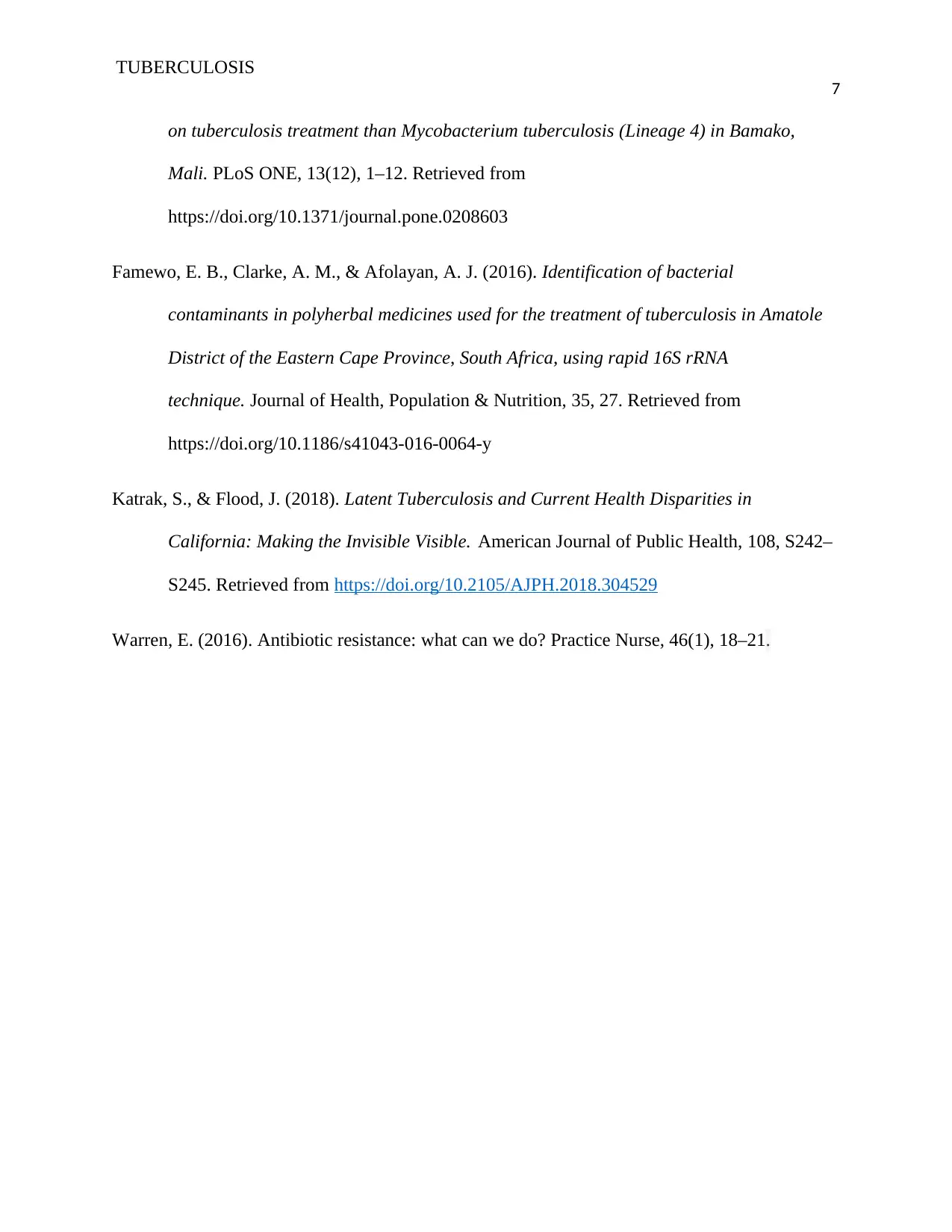
TUBERCULOSIS
7
on tuberculosis treatment than Mycobacterium tuberculosis (Lineage 4) in Bamako,
Mali. PLoS ONE, 13(12), 1–12. Retrieved from
https://doi.org/10.1371/journal.pone.0208603
Famewo, E. B., Clarke, A. M., & Afolayan, A. J. (2016). Identification of bacterial
contaminants in polyherbal medicines used for the treatment of tuberculosis in Amatole
District of the Eastern Cape Province, South Africa, using rapid 16S rRNA
technique. Journal of Health, Population & Nutrition, 35, 27. Retrieved from
https://doi.org/10.1186/s41043-016-0064-y
Katrak, S., & Flood, J. (2018). Latent Tuberculosis and Current Health Disparities in
California: Making the Invisible Visible. American Journal of Public Health, 108, S242–
S245. Retrieved from https://doi.org/10.2105/AJPH.2018.304529
Warren, E. (2016). Antibiotic resistance: what can we do? Practice Nurse, 46(1), 18–21.
7
on tuberculosis treatment than Mycobacterium tuberculosis (Lineage 4) in Bamako,
Mali. PLoS ONE, 13(12), 1–12. Retrieved from
https://doi.org/10.1371/journal.pone.0208603
Famewo, E. B., Clarke, A. M., & Afolayan, A. J. (2016). Identification of bacterial
contaminants in polyherbal medicines used for the treatment of tuberculosis in Amatole
District of the Eastern Cape Province, South Africa, using rapid 16S rRNA
technique. Journal of Health, Population & Nutrition, 35, 27. Retrieved from
https://doi.org/10.1186/s41043-016-0064-y
Katrak, S., & Flood, J. (2018). Latent Tuberculosis and Current Health Disparities in
California: Making the Invisible Visible. American Journal of Public Health, 108, S242–
S245. Retrieved from https://doi.org/10.2105/AJPH.2018.304529
Warren, E. (2016). Antibiotic resistance: what can we do? Practice Nurse, 46(1), 18–21.
1 out of 7
Related Documents
Your All-in-One AI-Powered Toolkit for Academic Success.
+13062052269
info@desklib.com
Available 24*7 on WhatsApp / Email
![[object Object]](/_next/static/media/star-bottom.7253800d.svg)
Unlock your academic potential
Copyright © 2020–2025 A2Z Services. All Rights Reserved. Developed and managed by ZUCOL.





